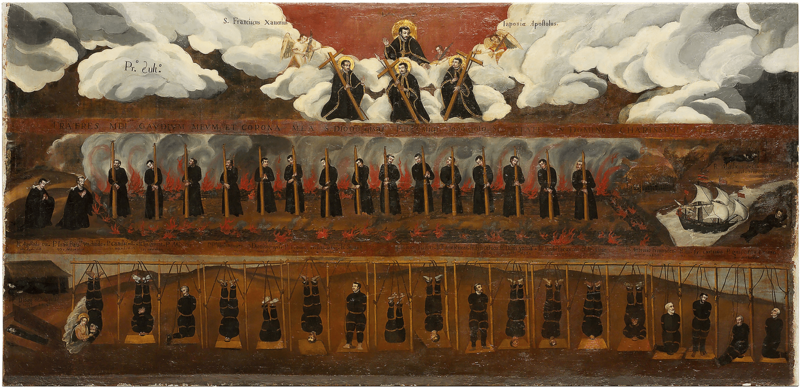Image: Martyrdom-of-Paul-Miki-and-Companions-in-Nagasaki-(made-c1635)

Description: On 5 February in 1597, St. Paul Miki (1564-1597), a Jesuit scholastic, and 25 others were martyred in Nagasaki. This painting shows the Jesuit Martyrs of Japan who were tortured and executed at Nagasaki in that century. After 1614, many Japanese Christians fled to Macau and Manila. It was painted by an anonymous Japanese painter in circa 1635. The painting is preserved in the Chiesa del Gesù, Rome, Italy. This painting is relatively large (110 x 220 cm). It was originally a watercolor painted on paper. Only later was it repainted in oil, attached to a canvas and framed, such as it is now to be found today (D’Orazio, 2008). Produced in an unquestionably kirishitan style, the painting depicts 44 Jesuits who were martyred in different ways in Japan, beginning with the first persecution. The painting has three separate levels. The top level represents glory: amid the clouds, and flanked by two angels, rise the figures of Francis Xavier, St Paul Miki and two companion Jesuits crucified in Nagasaki in 1597. They're recognized as martyrs by Rome, Paulo Miki, John Soan de Goto and James Kisai. The second level (middle) shows Christians burned at the stake, decapitated and those who lived in secrecy (hut) or exiled (galleon, abandoned on a shore). The third level (bottom) shows people subjected to the "tormento das covas" (being suspended upside down over a pit). They were tortured by hanging them over a pit filled with excrement. They would cut slits around their temples to release the pressure so they would die slower. The aim was to break the resolve of those who refused to renounce their faith.
Title: Martyrdom-of-Paul-Miki-and-Companions-in-Nagasaki-(made-c1635)
Credit: Analytical Science Journals https://analyticalsciencejournals.onlinelibrary.wiley.com/cms/asset/faf128c6-3bae-4cc3-add4-57df0aa740b5/xrs4000-fig-0004-l.jpg
Author: Anonymous Japanese Master (painter)
Usage Terms: Public domain
License: Public domain
Attribution Required?: No
Image usage
The following page links to this image:

